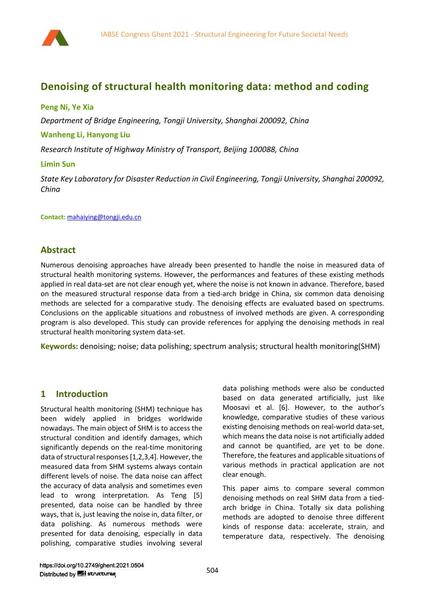Denoising of structural health monitoring data: method and coding

|
|
|||||||||||
Détails bibliographiques
| Auteur(s): |
Peng Ni
(Department of Bridge Engineering, Tongji University, Shanghai 200092, China)
Ye Xia (Department of Bridge Engineering, Tongji University, Shanghai 200092, China) Wanheng Li (Research Institute of Highway Ministry of Transport, Beijing 100088, China) Hanyong Liu (Research Institute of Highway Ministry of Transport, Beijing 100088, China) Limin Sun |
||||
|---|---|---|---|---|---|
| Médium: | papier de conférence | ||||
| Langue(s): | anglais | ||||
| Conférence: | IABSE Congress: Structural Engineering for Future Societal Needs, Ghent, Belgium, 22-24 September 2021 | ||||
| Publié dans: | IABSE Congress Ghent 2021 | ||||
|
|||||
| Page(s): | 504-510 | ||||
| Nombre total de pages (du PDF): | 7 | ||||
| DOI: | 10.2749/ghent.2021.0504 | ||||
| Abstrait: |
Numerous denoising approaches have already been presented to handle the noise in measured data of structural health monitoring systems. However, the performances and features of these existing methods applied in real data-set are not clear enough yet, where the noise is not known in advance. Therefore, based on the measured structural response data from a tied-arch bridge in China, six common data denoising methods are selected for a comparative study. The denoising effects are evaluated based on spectrums. Conclusions on the applicable situations and robustness of involved methods are given. A corresponding program is also developed. This study can provide references for applying the denoising methods in real structural health monitoring system data-set. |
||||
| Copyright: | © 2021 International Association for Bridge and Structural Engineering (IABSE) | ||||
| License: | Cette oeuvre ne peut être utilisée sans la permission de l'auteur ou détenteur des droits. |
||||
